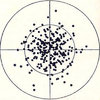KyleWoods35
Member
Well I took advantage of yesterday's unseasonably warm weather, it was 75 here in western PA! I made up some loads for my 204 using H4895 and 39 gr SBK's. Needless to say I am very please with my results. I am thinking of using 26.1 gr as my load, not only did it shoot very well but 26.0 and 26.2 have almost identical POI's. I also noticed that there really isn't much POI change from my lowest load to my highest. If you guys have any opinions on what you would pick for your OCW load feel free to chime in, I'm open to suggestions. I am planning on loading 1 round of 26, 26.1, and 26.2 and shooting at my max range I plan to shoot groundhogs at which will probably be 400 yards (had a 370 yard kill last year with 32 gr vmax factory ammo). I expect MOA results with those three shots. Here are a few pics of my setup and targets:
Savage Model 12 FCV
Mueller Eraticator 8.5-25x50

Top left target was my sighters with 24.1, 24.6, and 25.1 gr of H4895. I also used these to look for pressure signs.

Top left I used 4 shots of 32 gr Hornady factory ammo to foul the barrel.

Again, any input is welcome. I am new to reloading and am willing to learn from guys that have been reloading longer than I've been alive.
Savage Model 12 FCV
Mueller Eraticator 8.5-25x50

Top left target was my sighters with 24.1, 24.6, and 25.1 gr of H4895. I also used these to look for pressure signs.

Top left I used 4 shots of 32 gr Hornady factory ammo to foul the barrel.

Again, any input is welcome. I am new to reloading and am willing to learn from guys that have been reloading longer than I've been alive.



